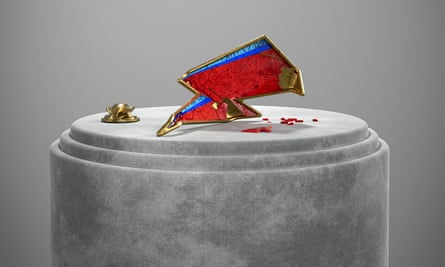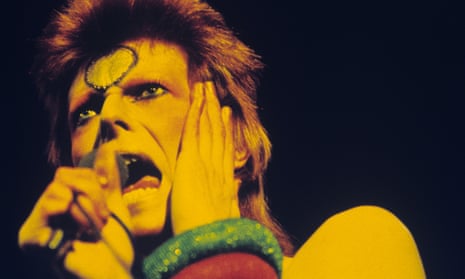Five years ago, in November 2017, I published an essay titled What Do We Do With the Art of Monstrous Men? It went viral right at the peak of the #MeToo avalanche. The Harvey Weinstein accusations had just been made public, followed by allegations against the comedian Louis CK, senator Al Franken, TV news stars Charlie Rose and Matt Lauer and many more. All this was set against the backdrop of the dawning of the Trump era, which was ushered in by the soon-to-be-president’s Access Hollywood tape, in which he described grabbing women by the pussy. Over the next months and years I travelled to college campuses to discuss this issue, and found the students I spoke to were as confused as I felt. Could they still watch Shakespeare in Love? Could they enjoy Louis CK in Parks and Recreation? Could they still listen to David Bowie?
I’ve spent my life being disappointed by beloved male artists: John Lennon hit his first wife; TS Eliot was antisemitic; Woody Allen began a relationship with his partner’s daughter Soon-Yi; Roman Polanski pleaded guilty to the statutory rape of 13-year-old Samantha Gailey (now Geimer). When I started to write about this problem, I realised I didn’t want to compile a catalogue of monsters – after all, wasn’t the history of art already that? I was trying to find out not about the artists, but about the audience.
These artists did or said something awful, and had made something great. The awful thing disrupts the great work; we can’t watch, or listen to, or read the great work without remembering the awful thing. Flooded with knowledge of the maker’s monstrousness, we turn away, overcome by disgust. Or … we don’t. We continue watching, separating or trying to separate the artist from the art. Either way: disruption. Polanski had become not his own problem, but my problem.
I wished someone would invent an online calculator – the user would enter the name of an artist, whereupon the calculator would assess the heinousness of the crime versus the greatness of the art and spit out a verdict: you could or could not consume the work of this artist. A calculator is laughable, unthinkable. Yet our moral sense must be made to come into balance with our art-love. I wanted for there to be a universal balance, a universal answer, though I suspected that this balance is different for everyone.

We don’t always love whom or what we’re supposed to love. Allen himself famously quoted Emily Dickinson: “The heart wants what it wants.” WH Auden said it more nicely, as he said almost everything more nicely: “The desires of the heart are as crooked as corkscrews.” We continue to love what we ought to hate. We can’t seem to turn the love off.
That’s not how everyone sees it, though. When I started to explore this problem, I discovered that male critics wanted the work to remain untouched by the life. The voice of authority says biography is fallacy. Authority believes the work exists in an ideal state (ahistorical, alpine, snowy, pure). Authority ignores the natural feeling that arises from biographical knowledge of a subject. Authority gets snippy about stuff like that. Authority claims it is able to appreciate the work free of biography, of history. Authority sides with the male maker, against the audience.
But, of course, we don’t decide to have the biography disrupt the work; it simply happens. The work is changed. And so a monster became, in my mind, an artist who simply could not be separated from some dark aspect of their biography. But the word “monster” was perhaps not the perfect appellation to contain the complexity of that idea and the shortcomings of the term were clarified to me one day when I was messaging with a music critic about Michael Jackson. He asked, about Jackson, after the Leaving Neverland documentary had detailed the abuse described by Jackson’s accusers: “Does the stain work its way backwards through time?”
This image of the stain immediately took hold of my brain. The word “monster” is like a suitcase packed full of rage – the rage that gives rise to the word’s utterance, the rage with which it is heard, whether by friend or foe of the monster in question. The stain is something else again. The stain is just plain sad. Indelibly sad. No one wants the stain to happen. It just does.

A couple of weeks later, I was eating breakfast at a diner when I Want You Back by the Jackson 5 came on. I bopped a little on my stool, I couldn’t help it. I found it hard to resist the pull of the music, borne on the air. And yet the moment was ruined too. I was placidly forking hash browns and all the while feeling like something terrible was (sort of) happening.
That’s how the stain works. The biography colours the song, which colours the sunny moment of the diner. When someone says we ought to separate the art from the artist, they’re saying: “Remove the stain.” Let the work be unstained. But that’s not how stains work. We watch the glass fall to the floor; we don’t get to decide whether the wine will spread across the carpet.
The stain begins with an act, a moment in time, but then it travels from that moment, like a teabag steeping in water, colouring the entire life. The principle of retroactivity means that if you’ve done something sufficiently asshole-like, it follows that you were an asshole all along. A woman says what happened to her, an abuse is revealed, and the stain travels backward, affecting and defining the perpetrator not just at the time of the abuse, and not just after the abuse, but before he committed the crime.
Strange idiosyncratic personal rules arise from such knowledge – I have a much easier time watching films that Polanski made before he raped Samantha Gailey. And yet at the same time, Polanski – predator, statutory rapist – collapses into Polanski the preternaturally talented Polish art student, wunderkind, Holocaust survivor. When we stream his 1962 psychological thriller, Knife in the Water, we wish we could give our few dollars to that blameless young Polanski. We wonder: how can we bypass this terrible old criminal? We can’t. We can’t even bypass our knowledge of what he’s done. We can’t bypass the stain. It colours the life and the work.
We might want to forget the stain – leave behind, or never acquire, this terrible knowledge of the maker’s biography. But there is no longer any escaping biography. Even within my own lifetime, I’ve seen a massive shift. Biography used to be something you sought out, yearned for, actively pursued. Now it falls on your head all day long. Now it seems impossible to shake work loose from biography. We swim in biography; we are sick with biography.
A truism of our moment in history is that we live in the time of the fan. As biography rises, as its shadow, cancel culture, escalates, fan culture also ascends. Yet this fandom, mysteriously, doesn’t make us more likely to prioritise the work over the biography. When what you like becomes important, becomes defining, becomes an obsession, then an artist’s biography has even more power than before. You have not just admired, not just consumed the art, you’ve become it. And therefore you have some new, much closer relationship with its maker.

The importance of our relationship with the artist’s biography is reaffirmed everywhere and all the time. Its signal quality is intimacy. The widespread use of the phrase “parasocial relationship”, a previously obscure sociological term that is being batted about the internet with greater and greater frequency, reflects the growing prevalence of the phenomenon it describes: the belief that we have real emotional connections with the artists whose work we love.
after newsletter promotion
We all know how this feels. It’s a different feeling from simply loving an artist’s work – it’s the feeling that you know this artist personally, as a friend, and what’s more, they possess the same knowledge of you. It’s a piece of obviousness that the internet has exacerbated this false-yet-extremely-real-feeling connection; indeed it could be said that this feeling of connection is the main product of social media; the commodity it is selling and reselling. And yet. It feels so real.
All of this is to say: when I come to this question – the question of what to do with the art of monstrous men – I don’t come as an impartial observer. I’m not someone who is absent a history. I have been a teenager predated by older men; I have been molested; I’ve been assaulted on the street; I’ve been grabbed and I’ve been coerced and I’ve escaped from attempted rape. I don’t say this because it makes me special. I say it because it makes me non-special. And so, like many or most women, I have a dog in this particular race.
I don’t come to these questions with a dispassionate point of view. I come as a sympathiser to the accusers. I am the accusers. And yet I still want to consume the art. Because, out in front of all of that, I’m a human. And I don’t want to miss out on anything. Why should I? Why should I be deprived of Polanski’s Chinatown or Woody Allen’s Sleeper? This tension – between what I’ve been through as a woman and the fact that I want to experience the freedom and beauty and grandeur and weirdness of great art – this is at the heart of the matter. It’s not a philosophical query; it’s an emotional one.
Your aesthetic experience may, in fact, be the opposite of disinterested; it might be deeply emotionally interested. Lived experience expands and illuminates the art we take in. Nostalgia, personal experience – these things become meaningful in terms of calculating the badness of the act against the greatness of the work. My answer is different from yours. I didn’t dance to R Kelly at my wedding reception; maybe you did. Maybe you want to revisit that memory. I didn’t imprint on the Black excellence represented by Bill Cosby’s Dr Huxtable; maybe you did. Maybe you need that image.
When Bowie died in 2016, I didn’t know how to express my feelings about his death or the magnitude of my love for him. I posted a couplet from his song “Five Years” (“Your face, your race, the way that you talk / I kiss you, you’re beautiful, I want you to walk”) and spent a few days going around feeling lower than I had any right to.

But then, in the weeks following his death, stories started to appear. An interview that the groupie Lori Mattix had given in 2015 resurfaced, telling how she lost her virginity to Bowie at the age of 15. Mattix didn’t begrudge Bowie her virginity; in fact she spoke of the incident in rhapsodic language: “I was an innocent girl, but the way it happened was so beautiful … Who wouldn’t want to lose their virginity to David Bowie?” I believed her, and I was left feeling horrified and sad.
This, then, is the very, very specific thing that students want to know: can they listen to David Bowie? The question is urgent. They need him. Young people are not dealing with nostalgia. They’re dealing with their own all-too-current feelings. For teenagers, music makes a kind of repository for feelings. So a betrayal by a musician becomes all the more painful – it’s like being betrayed by your own inner self.
Bowie was important to me in the same way when I was a weird kid. David Bowie was, in fact, the patron saint of weird kids. I played Bowie’s fourth album, Hunky Dory, every day in 10th grade – it seemed to stave off the inexplicable howling aloneness – and then my daughter did the same. For kids like me, there was a sense of ownership; Bowie was ours. His very existence was an assertion that aliens walked among us, so that when we ourselves felt alien, we might take comfort in the idea that we lived among a secret race, our true family. I brought all that to my listening to Bowie; I brought it as well to my digestion of the news of his stain.
This is what I tell the students: consuming a piece of art is two biographies meeting: the biography of the artist that might disrupt the consuming of the art; the biography of the audience member that might shape the viewing of the art. Your biography, your feelings are important. Not just your feelings of abhorrence for the deed, but your love for the work. The sense of beauty it brings into your life. Beauty is a fragile principle. It looks silly when it’s brought up against utility – or morality. When we mull over what to do about the art of monstrous men, beauty seems like a dandelion puff – the merest nothing – next to the loud j’accuse of saying how awful these men were in their personal lives. And yet. Beauty matters too. We don’t make decisions about beauty. Like the stain, beauty happens to us.
